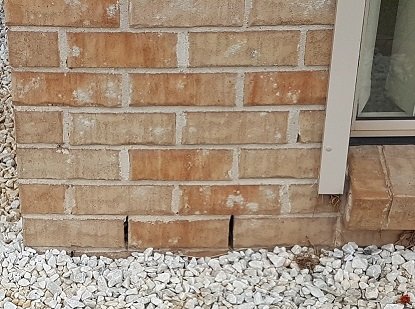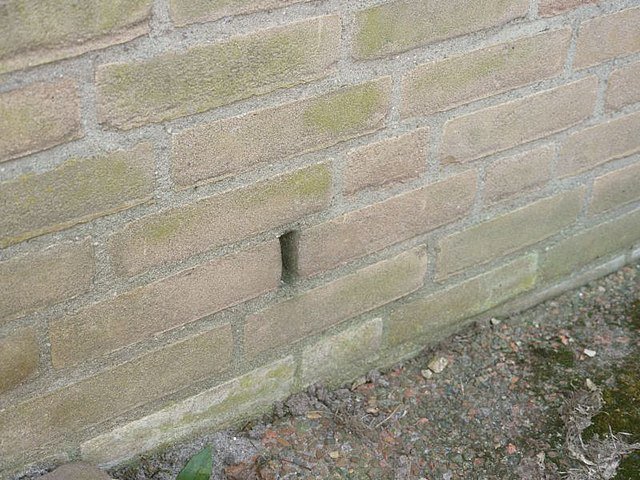Intro To Weep Holes in Walls
Ever wonder why some walls have tiny gaps, even in well-constructed buildings?
Well, those are weep holes, often overlooked elements in masonry construction. While they may look insignificant, they play a significant role in maintaining the durability and integrity of a building.
This article will guide you through everything you need to know about weep holes. We’ll explore what they are, why they are important, key features, appropriate placement, and even materials used for weep holes.
Can you guess the most common material used for weep holes? Read on to find out.
We will also discuss how to identify if your brick wall requires weep holes, how often they should be included in brickwork, and how to add them to an existing wall.
By the end of this article, you’ll have a comprehensive understanding of weep holes and their significance in maintaining the structural integrity of walls.
Table of Contents
Understanding the Purpose of Weep Holes in Walls

What Are Weep Holes?
Weep holes are small openings located at the bottom of a masonry wall. They are designed to allow the drainage of water that accumulates inside the wall.
Key Features of Weep Holes
- Typically small in size, usually around 3/8 to 1/2 inch in diameter.
- Placed at regular intervals along the wall’s base.
- Can be found in brick, stone, and other types of masonry construction.
Why Weep Holes Are Important
The primary purpose of weep holes is to ensure that any water which enters the wall cavity has a way to escape, thus preventing the build-up of moisture which can lead to various structural problems.
Benefits of Weep Holes
- Prevents Mold and Mildew: By draining water from within the wall, weep holes help to avoid the conditions that allow mold and mildew to grow.
- Reduces Water Pressure: Weep holes alleviate water pressure that can build up behind a wall, potentially causing structural damage.
- Protects Interior Spaces: Ensures that moisture doesn’t seep into the interior living spaces, protecting insulation and interior finishes.
Placement of Weep Holes
Proper placement of weep holes is important for their effectiveness.
Guidelines for Placing Weep Holes
- Spacing: Typically spaced 24 to 36 inches apart to ensure adequate drainage.
- Height: Placed about 6 inches above the ground level to prevent backflow from puddle water.
- Positioning: Often located at the lowest point of the wall’s cavity or right above the flashing layer.
Common Materials for Weep Holes
Weep holes can be created using various materials. Here are some common choices:
| Material | Description |
|---|---|
| Plastic Tubing | Durable and resistant to clogging; often pre-installed in bricks. |
| Rope Wicks | Absorbent ropes that guide water out; often used in retrofit projects. |
| Open Head Joints | Simply gaps left in the mortar, common in traditional masonry. |
Example of Weep Hole Use
In brick veneer constructions, weep holes are positioned to allow moisture that penetrates the brick to escape without affecting the wooden frame behind it. Properly installed weep holes thereby maintain the wall’s durability and the building’s overall structural integrity.
You can learn more about this concept in detail from Popular Mechanics.
Are Brick Weep Holes Necessary?

Understanding the Necessity of Brick Weep Holes
Brick weep holes play an important role in maintaining the structural integrity and longevity of masonry walls. While they may seem like minor details, their absence can lead to significant problems over time.
Potential Problems Without Weep Holes
The absence of weep holes can lead to various issues, including:
- Moisture Accumulation: Water that penetrates the brick layer has no escape route, leading to an accumulation of moisture within the wall cavity.
- Structural Damage: Over time, this trapped moisture can cause wood rot, corrosion of metal wall ties, and deterioration of the wall’s internal structure.
- Efflorescence: Without weep holes, moisture can seep through the masonry and bring salts to the surface, leaving unsightly white stains known as efflorescence.
Additional Functions of Weep Holes
Weep holes not only provide moisture drainage but also serve additional functions:
- Ventilation: Weep holes allow air to circulate within the wall cavity, promoting drying and reducing humidity levels. This ventilation helps keep the wall system dry and prevents conditions conducive to mold growth.
- Temperature Regulation: Proper air circulation through weep holes can help moderate wall cavity temperatures, preventing thermal stress on building materials that can lead to cracks and other damage.
Incorporating Weep Holes in Various Climates
The necessity of weep holes varies depending on the climatic conditions of a region:
- Humid Climates: In areas with high humidity and frequent rain, weep holes are especially essential for preventing moisture build-up and related problems.
- Dry Climates: Even in dry climates, occasional rain and condensation can cause moisture issues, making weep holes beneficial for long-term wall health.
- Cold Climates: In cold regions, freeze-thaw cycles can cause masonry to crack if moisture is trapped inside without relief provided by weep holes.
When looking at the inclusion of weep holes, it’s clear they serve an important function in maintaining the durability and health of masonry walls across various environments.
How Often Do You Put Weep Holes in Brickwork?

Considerations for Weep Hole Frequency
Understanding the correct interval for placing weep holes in brickwork is essential to ensure effective drainage and prevent structural issues. The frequency of weep holes can depend on several factors, such as the type of building, local climate, and the specific masonry materials used.
Standard Practices
- Interval Spacing: Weep holes are commonly spaced 24 to 36 inches apart. This spacing ensures that water can adequately drain from behind the masonry wall.
- Location-Specific Variations: In areas prone to heavy rainfall or high humidity, the spacing may be closer, around 16 to 18 inches apart, to provide better drainage.
Factors Influencing Weep Hole Spacing
Different factors can influence how often you need to install weep holes. These factors include the wall’s height, the type of bricks, and the climate.
Height of the Wall
- Taller Walls: For taller walls, it’s advisable to include a second row of weep holes higher up, akin to the guidelines followed for single-story and multi-story buildings. This ensures moisture is removed from different levels, preventing buildup at higher elevations.
Type of Bricks Used
- Permeable Bricks: Bricks that are more permeable may require weep holes at closer intervals since they allow water to pass through more easily.
- Non-Permeable Bricks: Less permeable bricks may allow for wider spacing as they do not allow as much water penetration.
Impact of Climate
- Humid and Rainy Areas: Closer spacing, around every 16 to 24 inches, helps manage large volumes of water effectively.
- Dry Climates: Standard spacing of 24 to 36 inches is typically sufficient since water penetration is less frequent.
- Cold Regions: Proper weep hole spacing prevents ice buildup inside the wall, reducing the risk of freeze-thaw cycles damaging the masonry.
Weep Hole Design and Additional Elements
Design considerations for weep holes extend beyond spacing. The design also includes ensuring the weep holes remain clear and functioning properly.
Preventing Blockages
- Insect and Debris Screens: To prevent blockages, install screens over the weep holes to keep out insects and debris while allowing water to flow through.
- Regular Maintenance: Periodically check and clean weep holes to ensure they are free from obstructions and working efficiently.
Enhancing Drainage Effectiveness
- Flashings: Properly installed flashings around the base and at intervals in the wall help direct water toward the weep holes, enhancing drainage efficiency.
- Gravel and Drainage Layers: Incorporating gravel or a drainage layer behind the brick can help direct water to the weep holes and prevent water from pooling within the wall cavity.
Can You Add Weep Holes to an Existing Brick Wall?
Why Add Weep Holes to an Existing Brick Wall?
Adding weep holes to an existing brick wall can be necessary if you notice signs of moisture accumulation, mold, or structural issues. Retrofitting weep holes ensures proper drainage and protects your building’s integrity.
Signs You Need Weep Holes
- Efflorescence: White, chalky deposits on the brick surface indicate salt and moisture migration.
- Mold and Mildew: Presence of mold or a musty smell indoors can indicate trapped moisture.
- Wall Deterioration: Rotting wood, rusting metal ties, or crumbling mortar joints are serious indicators.
Steps to Add Weep Holes to an Existing Brick Wall
Adding weep holes requires precise techniques to ensure effectiveness without compromising the wall’s structure.
Preparation
- Inspect the Wall: Check for existing damage or moisture issues before proceeding.
- Choose the Location: Weep holes should be spaced 24 to 36 inches apart along the wall’s base or above the flashing layer.
- Gather Materials: You’ll need a drill, masonry bit, and possibly tubing or screens to prevent debris blockage.
Drilling Weep Holes
- Mark the Spots: Use a measuring tape and chalk to mark the intended weep hole positions evenly.
- Drill the Holes: Carefully drill through the mortar joints, using a 3/8 to 1/2 inch masonry bit to create an appropriately sized hole.
- Install Tubing or Screens: Insert plastic tubing for a clean drainage path or use insect screens to prevent blockages.
Post-Installation Considerations
After installing weep holes, it’s essential to ensure they function properly.
Maintenance Tips
- Regular Inspections: Check periodically for blockages or signs of ineffective drainage.
- Cleaning: Use a wire to unclog holes if debris accumulates, especially after heavy rains.
- Monitor Wall Condition: Keep an eye on the wall’s condition. If issues persist, further examination or professional help may be necessary.
Additional Enhancements
- Flashings: Ensure that flashings are properly installed and intact to direct water towards the weep holes efficiently.
- Seal Cracks: Repair any additional cracks or gaps in the masonry to prevent water intrusion.
Summing Up: The Importance of Weep Holes in Masonry Walls
Weep holes play a significant role in the longevity and structural integrity of masonry walls. These holes, typically small in size, enable the drainage of water, thus preventing moisture buildup that could lead to structural damage. Placement is important and typically relies on guidelines that provide enough drainage without compromising aesthetic appeal.
The types of materials used for weep holes can vary, with options like plastic tubing, rope wicks, and open head joints. The climate and environment also influence the necessity and frequency of weep holes in a given structure.
Their absence can result in issues like mold growth, wall deterioration, and efflorescence, which is why retrofitting weep holes to existing brick walls can be an essential repair step.
Frequently Asked Questions – FAQs
What is the purpose of weep holes in walls?
Weep holes are used to drain water that accumulates within masonry walls. This allows the wall to stay dry, preventing buildup of moisture that could potentially lead to mold growth or structural damage.
How often should weep holes be placed in brickwork?
Weep holes are typically spaced 24 to 36 inches apart. However, this can vary depending on local climate conditions and the specific masonry materials used.
Can I add weep holes to an existing brick wall?
Yes, adding weep holes to an existing brick wall is not only possible but sometimes necessary. If signs of moisture accumulation, mold, or structural issues start appearing, retrofitting weep holes can protect the building’s integrity.
How do I maintain and care for weep holes?
Weep holes should be periodically checked for blockages and cleaned if necessary to ensure effective drainage. Also, continuous monitoring of the wall’s condition is important to identify any persisting issues.






